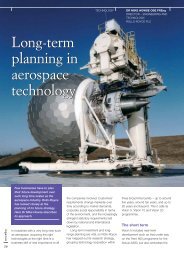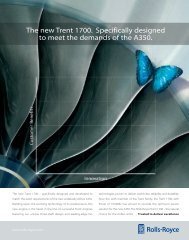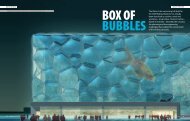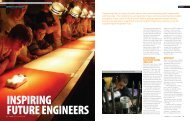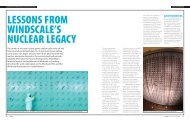Gas turbine technology - Ingenia
Gas turbine technology - Ingenia
Gas turbine technology - Ingenia
Create successful ePaper yourself
Turn your PDF publications into a flip-book with our unique Google optimized e-Paper software.
EARTH, AIR AND WATER<br />
imperative. The continual drive to<br />
maximise fleet utilisation while<br />
minimising unscheduled delays is a<br />
feature of modern civil aviation that is<br />
likely to intensify. Aircraft turnaround<br />
times, currently as tight as 20 minutes,<br />
will be further reduced, demanding<br />
robust products that excel in<br />
demanding conditions.<br />
As an inevitable result of the<br />
explosion in civil travel, our skies – and<br />
our airports – are becoming increasingly<br />
congested. This is a reality affecting<br />
governments, town planners and global<br />
air traffic management systems, and<br />
one that requires radical reappraisal<br />
from the aviation industry on the future<br />
of civil transport. Should aircraft makers<br />
focus on bigger jets to carry more<br />
people or faster aircraft with more<br />
range, to get people to their<br />
destinations without stopping off and in<br />
less time than it takes current subsonic<br />
aircraft?<br />
A further development resulting from<br />
the growth in air travel is the hot debate<br />
surrounding emissions. These are an<br />
unavoidable by-product of burnt fossil<br />
fuels and are the target of increasingly<br />
stringent global environmental<br />
legislation. So aircraft makers and<br />
associated suppliers must develop<br />
products that continue to mitigate their<br />
impact on our atmosphere.<br />
For aero engine makers the<br />
challenge is to design, manufacture and<br />
bring to market products that are<br />
increasingly reliable, efficient, kind to the<br />
environment and affordable, all of which<br />
present their own unique engineering<br />
challenges. The research and<br />
development spends necessary to<br />
achieve these goals in the specialised<br />
aero engine industry are considerable.<br />
Thus Rolls-Royce has developed<br />
engine technologies which have the<br />
inherent design capability to transfer<br />
across to new engine variants and be<br />
retrofitted on existing ones.<br />
applied builds on the established<br />
principles of the gas <strong>turbine</strong> engine,<br />
commonly known as the ‘jet’ engine.<br />
Since the advent of gas <strong>turbine</strong><br />
<strong>technology</strong> in the 1930s, the total<br />
power output that can be achieved has<br />
increased by a factor of 50 while fuel<br />
requirements (specific fuel<br />
consumption) have been cut by 75%.<br />
These milestones have been driven by<br />
the development of advanced<br />
<strong>technology</strong> in many areas, amongst<br />
them thermodynamics, aerodynamics<br />
and materials science.<br />
Like the motor car engine, the gas<br />
<strong>turbine</strong> is an internal combustion<br />
engine. In both, air is compressed, fuel<br />
added, the mixture ignited and the<br />
rapid expansion of the resultant hot gas<br />
produces the power. Unlike the motor<br />
car engine, however, where power is<br />
intermittent and the expanding gas<br />
produces shaft power through a<br />
mechanical piston and crank, in a jet<br />
engine combustion is continuous and<br />
its power results from expanding gas<br />
being forced out of the rear of the<br />
engine. The jet engine relies on<br />
Newton’s Third Law where every action<br />
has an equal and opposite reaction.<br />
The expanding gas flow is an action<br />
which creates a reaction of equivalent<br />
force, referred to as thrust. Thrust is<br />
transmitted through the engine to the<br />
aircraft, propelling it through the air.<br />
The first gas <strong>turbine</strong> engines to fly in<br />
service were turbojets, used in a variety<br />
of military applications. Relying on highvelocity<br />
hot gas passing entirely through<br />
the compressor, combustor and<br />
<strong>turbine</strong>s to provide thrust, this engine is<br />
designed primarily for speed, but<br />
carries the penalties of relatively high<br />
fuel consumption and noise levels.<br />
The turbo prop, as its name<br />
suggests, uses a propeller to transmit<br />
the power it produces into thrust. The<br />
propeller is driven by a shaft from a<br />
power <strong>turbine</strong>, utilising the gas energy<br />
which would provide the thrust directly<br />
in a turbo jet. Similarly, the turbo shaft<br />
powerplant for helicopters uses a<br />
power <strong>turbine</strong>, but in this instance the<br />
power is transmitted to the rotor<br />
system of the helicopter. This type of<br />
engine is also used in industrial and<br />
marine applications, where it can drive<br />
electrical generators, pumps or a<br />
variety of marine propulsors.<br />
Today, modern, large civil transport<br />
aircraft are powered by turbo fan<br />
engines. In these ‘bypass’ gas <strong>turbine</strong>s<br />
a large mass of air is pressurised by a<br />
big fan at the front of the engine – at<br />
take off a Trent 800 powering a Boeing<br />
777 would empty all the air in a squash<br />
court in a third of a second. Some of<br />
this air then passes through the engine<br />
core, where it is further pressurised<br />
before the combustion and expansion<br />
processes. The remaining fan air flows<br />
through the bypass duct, re-mixes with<br />
the hotter core gas and leaves through<br />
the nozzles as the jet which provides<br />
the engine’s thrust.<br />
The bypass ratio – the mass of air<br />
going down the bypass stream divided<br />
by the mass going through the core – is<br />
the principal difference between<br />
modern civil and military aero engines.<br />
For example, the EJ200 engine built for<br />
the Eurofighter has a bypass ratio of<br />
ingenia<br />
14<br />
The jet engine<br />
The basis on which most short- to<br />
medium-term research is focused and<br />
Figure 1: The jet engine.





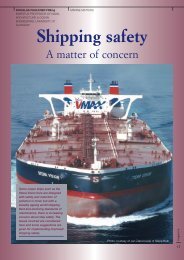

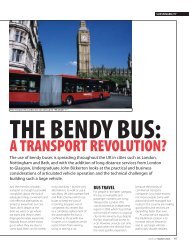
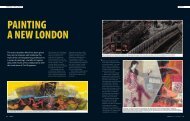
![[322/03] Francke - Ingenia](https://img.yumpu.com/23411337/1/184x260/322-03-francke-ingenia.jpg?quality=85)

